About the talk
- Some concepts and terminology
- Tour of some algorithmic approaches mostly by example
- Musical examples
- Historical examples
- Practical demonstration
- Discussion
What is algorithmic music?
- Music created by process
- Not just for computers
- Can be deterministic or indeterminate
- Can be executed in many domains
Names for algorithmic music
- Process music
- Generative music
- Procedural music
- Aleatoric music
- Stochastic music
- Chance operations
Types of process
(not meant to be exhaustive or exclusive - lots of crossover)
Software processes
- Software algorithms / Software scores
- Algorithm: set of instructions that describe a process to be carried out by a computer
- Random number generators
- Probability tables, markov chains, oh my
- Brownian motion / drunk walks
- Procedural recipes (if this then that)
- Machine learning systems
- Actual artificial intelligences ... SIKE!
- Computational creativity (true AI)
Music Ex: Laurie Spiegel
A Harmonic Algorithm (1981 Version)
- Written in Apple Pascal & 6502 assembly for an Apple II with Mountain Hardware oscillator boards.
- Algorithm describes compositional decisions (in this case modeled after Bach) which generate movement based on initial conditions.
- Described in detail in her 1982 paper Sonic Set Theory: A Tonal Music Theory for Computers.
Music Ex: Autechre
acdwn2 from elseq 1
- Simple rhythmic / pitch ostinato adds foundation around algorithmic variation in timbre.
- The melody is really in the timbral transformation/articulation of each synth layer in phrases & over longer periods of time.
"It seems that for a lot of people, if they hear something that doesn't sound regular, they assume it's random. If live musicians were playing it, they'd probably call it jazz or something. But the fact that it's coming out of a computer, as they perceive it, somehow seems to make it different. For me it's just messing around with a lot of analogue sequencers and drum machines. It's like saying, 'I want this to go from this beat to that beat over this amount of time, with this curve, which is shaped according to this equation." - Sean Booth
Human processes
- A sequence of coded or natural language instructions for a human to carry out.
- Written scores using indeterminate notation
- Graphical scores
- Game pieces
Music Ex: Mark Applebaum
stog
- Performed on the Mouseketeer sound sculpture
- Score is based on subway maps read in multiple directions by the performer
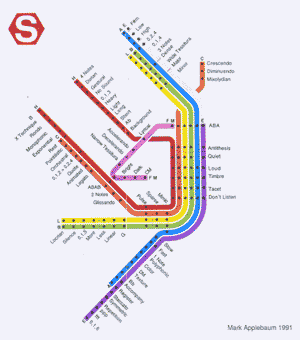
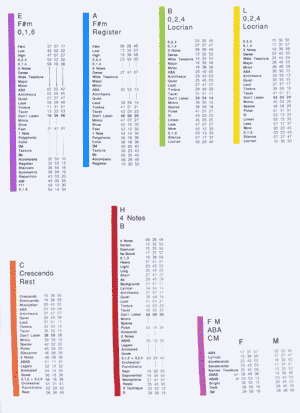
Music Ex: Terry Riley
In C
- Score consists of musical fragments
- Piece is performed by performers moving freely through the score based on a simple set of instructions.
- Ensemble moves from unison to polyphony and back as performers phase around each other
Music Ex: Marina Rosenfeld
Sheer Frost Orchestra
- Ensemble of amateur musicians
- Pre-performance workshops to teach how to read graphic scores & how to play extended techniques invented by Rosenfeld using guitars and nail polish bottles
- Performers follow graphic scores composed by Rosenfeld
Mechanical & electro-mechanical processes
- Artificial physical systems
- Electronic & electro-mechanical systems
- Rube Goldberg-like use of physics
Music Ex: Graham Dunning
Mechanical Techno Demonstration
- Multi-level turntable
- Various physical systems for triggering and producing sounds
- Light theremin with interfering optics
Mechanical Techno Demonstration
- Multi-level turntable
- Various physical systems for triggering and producing sounds
- Light theremin with interfering optics
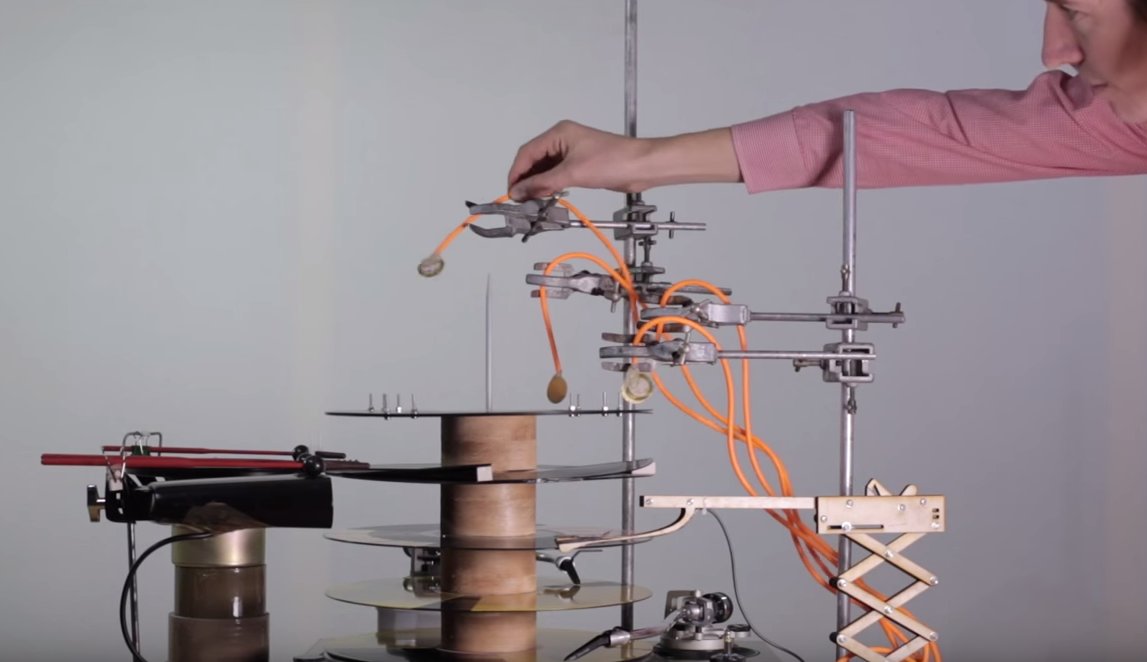
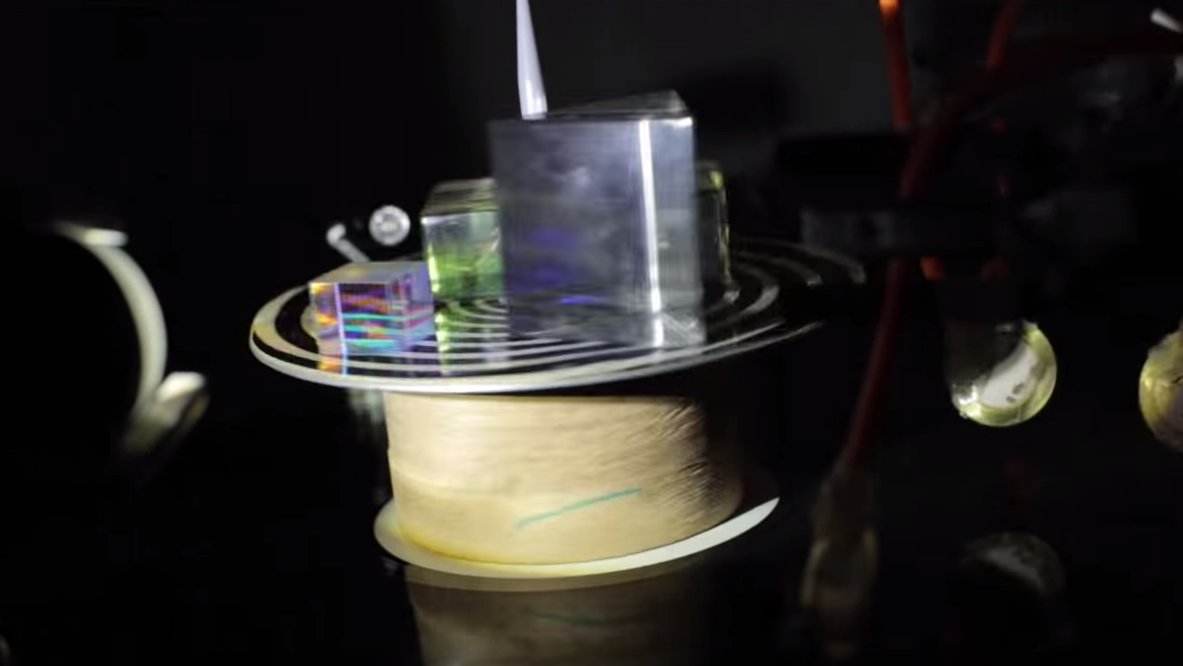
Music Ex: David Tudor
Neural Synthesis No. 6
- Based around an analog neural network chip designed by Intel
"The neural-network chip forms the heart of the synthesizer. It consists of 64 non-linear amplifiers (the electronic neurons on the chip) with 10240 programmable connections. Any input signal can be connected to any neuron, the output of which can be fed back to any input via on-chip or off-chip paths, each with variable connection strength. The same floating-gate devices used in EEPROMs (electrically erasable, programmable, read-only memories) are used in an analog mode of operation to store the strengths of the connections. The synthesizer adds R-C (resistance-capacitance) tank circuits on feedback paths for 16 of the 64 neurons to control the frequencies of oscillation. The R-C circuits produce relaxation oscillations.
Interconnecting many relaxation oscillators rapidly produces complex sounds. Global gain and bias signals on the chip control the relative amplitudes of neuron oscillations. Near the onset of oscillation the neurons are sensitive to inherent thermal noise produced by random motions of electron groups moving through the monolithic silicon lattice. This thermal noise adds unpredictability to the synthesizer's outputs, something David found especially appealing.
The synthesizer's performance console controls the neural-network chip. R-C circuits, external feedback paths and output channels. The chip itself is not used to its full potential in this first synthesizer. It generates sound and routes signals but the role of learner, pattern-recognizer and responder is played by David, himself a vastly more complex neural network than the chip. During performances David chooses from up to 14 channels of synthesizer output, modifying each of them with his other electronic devices to create the final signals." - Forrest Warthman (liner notes)
Natural processes
- Natural physical processes
- Sonification / manipulation of abstract data (bird migration data, fish population stats, weather patterns...)
- Using sensors or special microphones to make non-audio signals audible
- Radio / cosmic radiation
- Field recordings as data
Music Ex: Andrea Polli
Sonic Antarctica
- Combines field recordings, interviews, and environmental data sonifications
- A Model Is A Cartoon Antarctic ice acceleration data from Slawek Tulaczyk and
Jake Walter of UC Santa Cruz
- Taylor Glacier Glacier weather station data 2007 compiled by Hassan Basagic
of the McMurdo Dry Valleys Long Term Ecological Research (LTER) Project; Automatic Weather Station (AWS)
maintenance at Windless Bight
Sonic Antarctica
- Combines field recordings, interviews, and environmental data sonifications
- A Model Is A Cartoon Antarctic ice acceleration data from Slawek Tulaczyk and Jake Walter of UC Santa Cruz
- Taylor Glacier Glacier weather station data 2007 compiled by Hassan Basagic of the McMurdo Dry Valleys Long Term Ecological Research (LTER) Project; Automatic Weather Station (AWS) maintenance at Windless Bight
Data processes
- Chaotic and fractal spaces
- Sonification / manipulation of data sets (server logs, artificial system sensor readings...)
- Synthetic systems / physical models
Music Ex: He Can Jog
cat /var/log/httpd/* | aplay -r 44100 -c 2
- Sonification of apache server logs
- Algorithm is the direct mapping of 8bit ascii characters to two interleaved channels of 16 bit PCM audio
- Repetition in the log files simulates oscillation in the sonification and produces pitches
- A strangely mapped wavetable synth
Music Ex: Hanne Darboven
Opus 60 - Furioso
- Symphony for 120 players
- Based on transcriptions of calendar dates
- Created systems for translating numbers into musical notes and expressions
Music Ex: Hanne Darboven
Opus 17a
- Also uses a translation system to generate a musical score from calendar dates
- Performed by Robert Black
Music Ex: EVOL
Opus 17a (live at Issue Project Room)
- Guy Birkin provided pitch and rhythmic data extracted from an analysis of the first 12 minutes of the Robert Black recording.
- Many realizations for different synthesizers and drum machines
- Solo computer (Roc Jimenez de Cisneros) with strobe lights and giant pink bunny
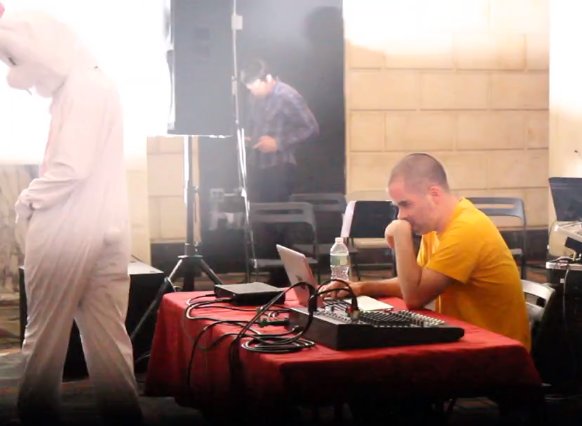
A Couple Historical Examples
Music Ex: Marcel Duchamp
The Bride Stripped Bare by Her Bachelors Even. Erratum Musical
- Written circa 1912
- Realization by Petr Kotik for pianola
- Used same system to construct pitches and rhythms
- Score is for a mechanical instrument
- Composed with a contraption that generates "musical periods": a set of 85 balls corresponding to musical notes which fall into a funnel and are dropped into passing "cars" moving at different speeds.
Music Ex: Lejaren Hiller
Illiac Suite - Movement IV
- Programmed on the ILLIAC I computer at the University of Illinois at Urbana-Champaign from late 1955 to 1957
- Collaborated on programming with Leonard Isaacson
- 4th movement uses markov chains / probability tables to construct score
- Score generated by computer for string quartet
- Encoding of compositional process
- Information theory
An Aside On Agenda
- Audible process
- Inaudible process
- Compositional helper
- Stylistic synthesis
- Toward a new aesthetic
no ai
just humans and tools

Thanks!
Demonstration
- A random melody
- Restricted random
- With harmony
- Adding the logistic equation
- Polyphony
- Drums etc...
- What else?